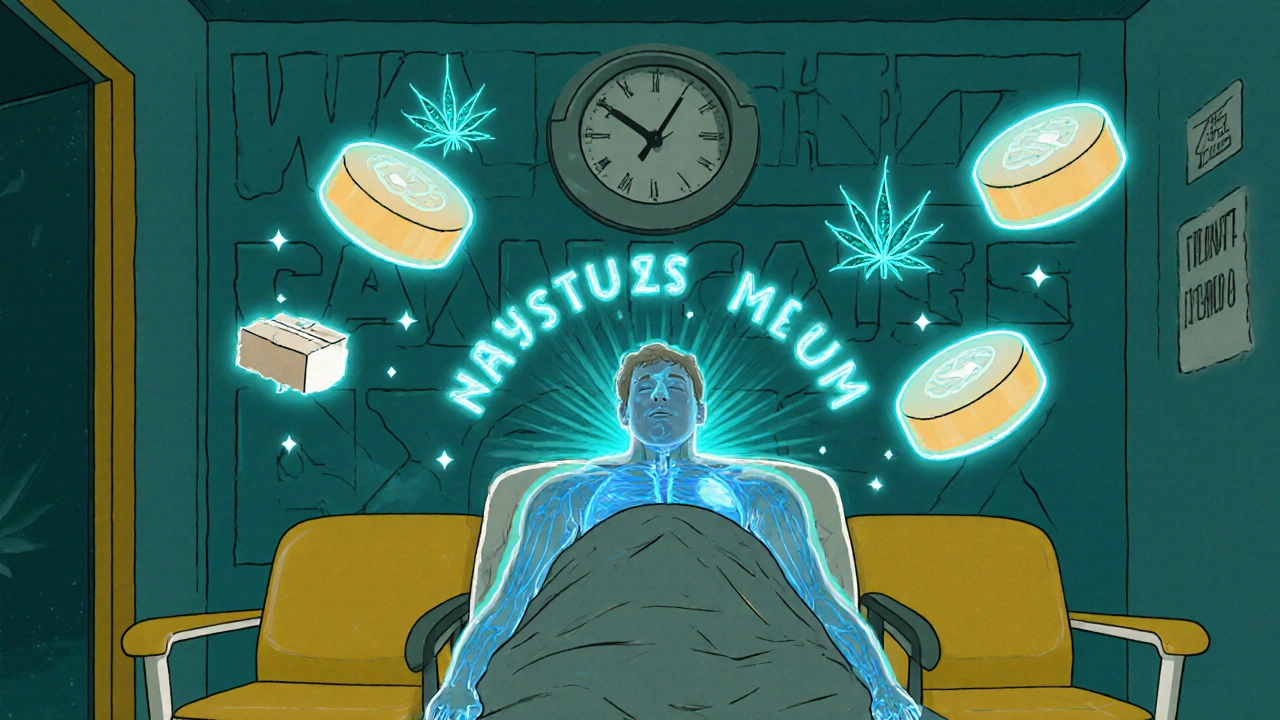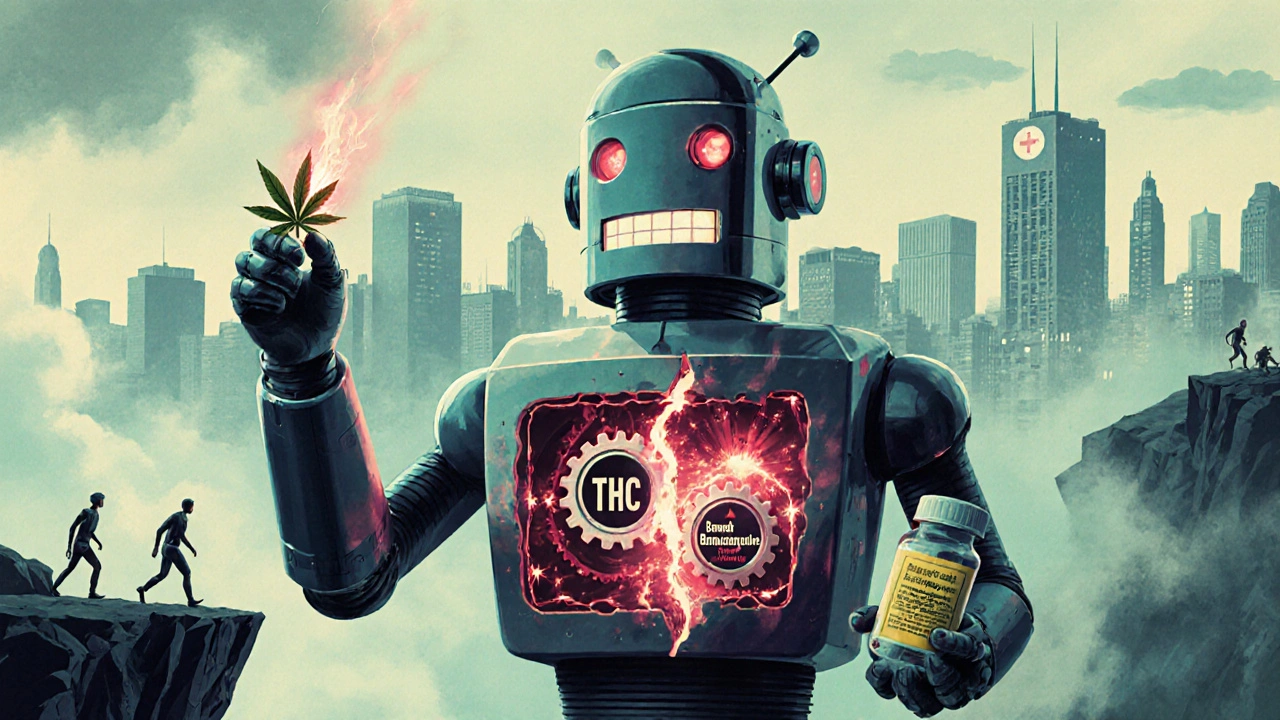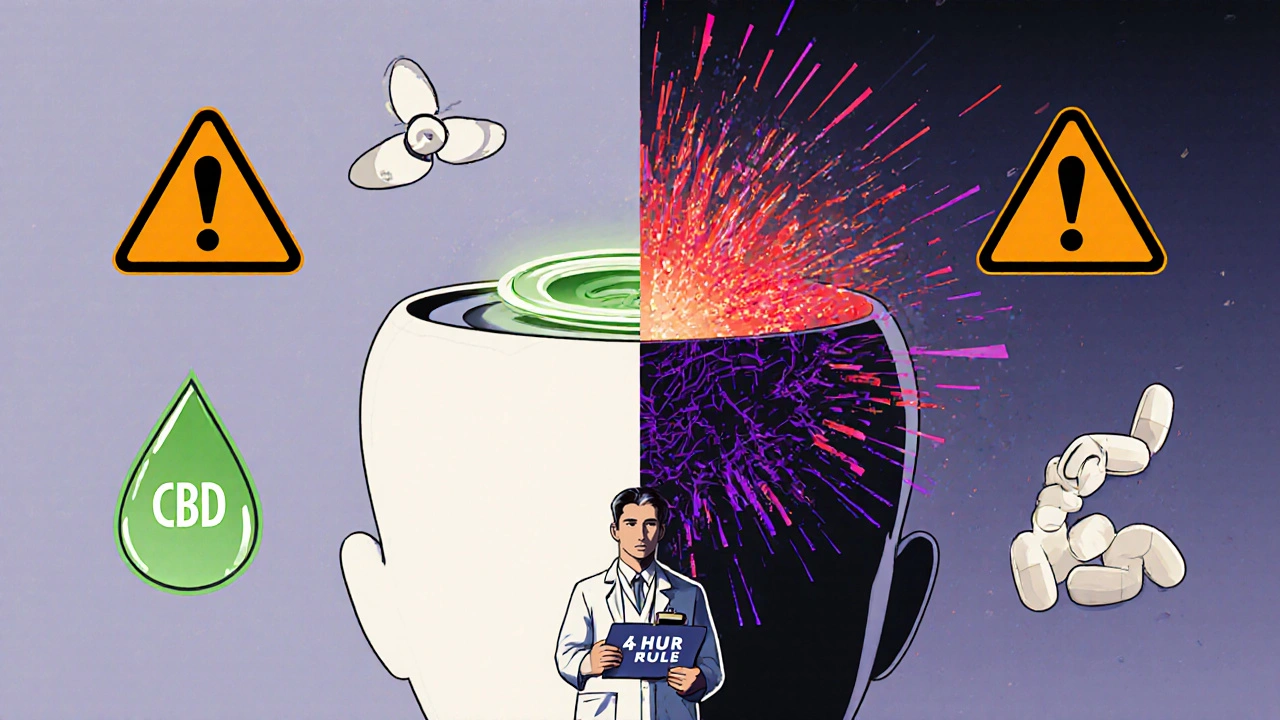Cannabis and CNS Depressants: Understanding Additive Sedation and Real Risks
 Nov, 19 2025
Nov, 19 2025
CNS Depressant Interaction Risk Calculator
Risk Assessment
Warning signs to watch for:
- Extreme drowsiness or difficulty staying awake
- Slurred speech or confusion
- Slow or shallow breathing
- Blue lips or fingertips
Safety Recommendations:
When you take cannabis with a sleeping pill, painkiller, or anti-anxiety medication, you’re not just adding two effects-you’re multiplying them. This isn’t theory. It’s happening in emergency rooms across the UK and US, where people wake up confused, struggling to breathe, or with no memory of how they got there. The problem isn’t just about getting too high. It’s about your body slowing down too far-and not waking up.
How Cannabis Acts Like a Sedative
Cannabis isn’t just a party drug or a wellness trend. At its core, it’s a central nervous system (CNS) depressant. That means it slows down brain activity, just like alcohol, benzodiazepines, barbiturates, and opioids. The main ingredient responsible is delta-9-tetrahydrocannabinol (THC). When THC binds to CB1 receptors in the brain, it triggers relaxation, drowsiness, and reduced anxiety. But it also slows reaction time, messes with short-term memory, and makes it harder to focus. These effects start within minutes if you smoke it, and peak around 30 minutes. If you eat it, like in a gummy or brownie, it takes longer-up to 90 minutes to kick in-and can last 6 to 8 hours.Even small amounts matter. A single hit of 20% THC flower or 10 mg of THC in an edible is enough to noticeably impair coordination and thinking. And it’s not just new users. Experienced users still feel these effects. The body doesn’t fully build tolerance to the sedative impact, especially when combined with other drugs.
What Are CNS Depressants?
CNS depressants are medications that calm the nervous system by boosting a brain chemical called GABA. This reduces overactivity, which is why doctors prescribe them for anxiety, seizures, insomnia, and muscle spasms. Common ones include:- Benzodiazepines (like Xanax, Valium, Klonopin)
- Barbiturates (older sleep aids like phenobarbital)
- Opioids (like oxycodone, hydrocodone, morphine)
- Sleep medications (like zolpidem or eszopiclone)
- Sometimes even over-the-counter antihistamines (like diphenhydramine in Benadryl)
All of these slow breathing, lower heart rate, and dull mental alertness. When you add cannabis to the mix, you’re stacking depressants. The result? The combined effect isn’t just 1 + 1 = 2. It’s more like 1 + 1 = 3. That’s called additive or even synergistic sedation. The drugs don’t just sit side by side-they amplify each other.
The Danger: Slowed Breathing and Overdose Risk
The scariest part isn’t feeling sleepy. It’s when your breathing slows to dangerous levels. Both cannabis and opioids suppress the brain’s drive to breathe. When you combine them, the risk isn’t just higher-it’s multiplicative. A 2020 study in the Journal of Clinical Medicine found that people using cannabis with benzodiazepines were 3.2 times more likely to end up in the ER. Of those visits, 67% involved breathing problems.Real cases back this up. One Reddit user, after taking half a milligram of Xanax and one hit of high-THC flower, woke up on the bathroom floor with oxygen levels at 82%-dangerously low. The Substance Abuse and Mental Health Services Administration (SAMHSA) reported over 7,800 emergency visits in 2022 involving cannabis and benzodiazepines alone, up 42% since 2019.
Even more alarming: patients using cannabis alongside opioids needed higher doses of anesthesia during surgery and had 37% more breathing complications during recovery, according to research from Washington University. This isn’t rare. A 2021 survey of 1,247 medical cannabis users found that nearly 4 out of 10 were also taking prescription depressants-and over 1 in 5 had experienced an episode so severe they needed medical help.

Who’s Most at Risk?
Some groups are far more vulnerable:- Older adults (65+): Their bodies process drugs slower. They’re also more likely to be on multiple medications.
- People with lung or heart conditions: Slowed breathing puts extra strain on the body.
- Those using high-THC products (>15%): The higher the THC, the stronger the sedative effect.
- People using edibles: The delayed onset means users often take more, thinking it’s not working-then get hit with a double dose.
Doctors are seeing this more often. In California, mandatory training for physicians certifying medical cannabis patients led to a 28% drop in dangerous combinations after 2022. That’s not luck-it’s awareness.
What About CBD?
Not all cannabis products are the same. CBD, the non-intoxicating compound, doesn’t bind strongly to CB1 receptors and doesn’t cause sedation. In fact, a 2022 study in JAMA Internal Medicine found that high-CBD, low-THC oil (150mg CBD, less than 0.3% THC) showed no significant interaction with alprazolam (Xanax). For people seeking relief without the risk, CBD-dominant products may be a safer option.But be careful: many products labeled “CBD” still contain enough THC to cause problems. Always check lab reports. If a product has more than 0.3% THC, treat it like any other cannabis product-with caution.

What Should You Do?
If you’re using cannabis and a CNS depressant, here’s what you need to know:- Don’t assume it’s safe. Just because something is “natural” or “prescribed” doesn’t mean it’s safe to mix.
- Talk to your doctor. Tell them everything you’re taking-including gummies, vape pens, and tinctures. Don’t leave anything out.
- Avoid high-THC products. Stick to low-dose THC (under 5mg) if you must use both.
- Space out doses. If you’re taking both, wait at least 4 hours between them. Never combine them right before bed or driving.
- Watch for warning signs. Extreme drowsiness, confusion, slurred speech, slow breathing, or memory blackouts mean stop immediately and seek help.
The American Medical Association and CDC both recommend screening for cannabis use before prescribing any CNS depressant. If your doctor doesn’t ask, bring it up. Your life could depend on it.
What’s Being Done?
Regulators are catching up. The FDA now requires all prescription CNS depressants to carry warnings about cannabis interactions. The European Medicines Agency did the same in 2023. In the U.S., states with medical cannabis programs are starting to require physician training. The National Institutes of Health increased funding for interaction research from $28 million in 2020 to over $140 million in 2023.Tools are emerging too. The American Society of Health-System Pharmacists created a risk calculator that scores THC strength, depressant type, and patient age. A score above 7 means high risk-and it’s time to reconsider your treatment plan.
The Bottom Line
Cannabis can help with pain, anxiety, or sleep. But it’s not harmless. When mixed with sedatives, it becomes a silent threat. The risk isn’t theoretical. It’s documented. It’s rising. And it’s preventable.If you’re using cannabis alongside any medication that makes you drowsy, you’re playing with fire. You don’t need to quit either one-but you do need to understand the danger. Talk to your doctor. Use low doses. Avoid high-THC products. And never combine them without knowing what you’re risking.
One hit might seem harmless. But when it’s paired with a pill that already slows your breathing, it can be the last one you take.
Can I use CBD with benzodiazepines?
CBD alone, especially in products with less than 0.3% THC, shows little to no interaction with benzodiazepines like Xanax or Valium. A 2022 study found no significant pharmacokinetic changes when high-CBD oil was taken with alprazolam. However, always check the product’s lab report. Many so-called CBD products contain hidden THC, which can still cause dangerous sedation. If in doubt, talk to your doctor before combining them.
How long should I wait between taking cannabis and a depressant?
The National Institute on Drug Abuse recommends staggering doses by at least 4 hours. This gives your body time to process one substance before introducing another. But this isn’t a guarantee of safety-especially with edibles, which last longer. If you’re on opioids or benzodiazepines, the safest choice is to avoid cannabis entirely unless your doctor approves a strict, low-dose plan.
Is medical cannabis safer than recreational cannabis with depressants?
No. Medical cannabis isn’t safer-it’s just regulated. That means you might get more consistent dosing and lab-tested products, but the active ingredient (THC) still acts the same way in your brain. Whether it’s from a dispensary or a friend, 10 mg of THC will still slow your breathing if combined with a depressant. The risk comes from the chemistry, not the source.
What are the signs of dangerous sedation from mixing cannabis and depressants?
Warning signs include extreme drowsiness, difficulty staying awake, slurred speech, confusion, slow or shallow breathing, blue lips or fingertips, memory blackouts, or waking up disoriented with no memory of recent events. If you or someone else shows these signs, call emergency services immediately. Respiratory depression can be fatal within minutes.
Can I use cannabis instead of my prescribed depressant?
Never stop or replace a prescribed medication without consulting your doctor. While some patients have successfully reduced opioid use with low-dose THC under medical supervision, this requires careful monitoring, precise dosing, and regular follow-ups. Self-medicating with cannabis instead of your prescribed drug can lead to withdrawal, worsening symptoms, or uncontrolled interactions. It’s not a swap-it’s a medical decision that needs professional guidance.

Alyssa Torres
November 20, 2025 AT 05:30I saw a friend nearly die from this last year. She took her Xanax and a gummy, thought she was just gonna chill, woke up on the floor with her roommate screaming for 911. They thought she was dead. Turned out her O2 was at 79%. She’s fine now, but she doesn’t touch either anymore. This isn’t a joke. It’s a silent killer.
My mom’s 72 and on a low-dose benzo for anxiety. I made her delete all her edibles after reading this. She cried. Said she didn’t know. Nobody tells you this stuff.
Doctors need to stop acting like cannabis is just ‘weed’ and start treating it like the CNS depressant it is. It’s not ‘natural’ if it’s shutting down your breathing.
I’m so glad this post exists. We need way more awareness.
Also-CBD is fine. I take 50mg daily with my antidepressant and zero issues. But if it’s got THC? No. Not even a puff. Not worth it.
Summer Joy
November 20, 2025 AT 11:16OMG I KNEW IT 😭 I took a hit and my Ambien like 3 hours later and I woke up in the bathtub with my pants on backwards. I thought I was in a dream. I didn’t even know how I got there. I thought I’d died and gone to heaven. Then I saw my cat licking my face. I screamed. I’m not even joking. I’ve been scared to touch anything since. Like… what if I never woke up? 😵💫
Shiv Karan Singh
November 22, 2025 AT 04:24Bro this is just fearmongering. I’ve been smoking daily for 10 years and take melatonin every night. Never had an issue. People are weak. Your body adapts. Stop acting like cannabis is crack. It’s a plant. Not a chemical weapon. Also, the FDA? Please. They banned CBD for 80 years and now they’re scared of it? Wake up.
Also-your ‘study’? Correlation ≠ causation. You think people are dying from cannabis? Nah. They’re dying from bad choices. And bad doctors.
Also-CBD? It’s just a placebo. I’ve tried it. Didn’t do jack. Just water with extra steps.
Matthew Karrs
November 22, 2025 AT 11:04They’re hiding the truth. This isn’t about safety. It’s about control. Big Pharma doesn’t want you to know you can replace opioids with weed. They make billions off prescriptions. That’s why they’re pushing these ‘risks’-to scare you away from the real solution. The ER stats? Probably inflated. How many of those people were also drinking? They don’t say. They never say.
And why are they suddenly ‘warning’ about cannabis now? Coincidence? Or is it because weed sales are eating into their profits?
Trust nothing. Always question the source. This post? Sounds like a pharma ad with a hemp logo.
Matthew Peters
November 23, 2025 AT 08:07I’m a 34-year-old chronic pain patient. I use 5mg THC gummies for sleep and 10mg oxycodone for flare-ups. I space them 6 hours apart. Never had a problem. But I also don’t mix them on the same night. I’m not reckless. I’ve seen people go to sleep and never wake up. It’s terrifying.
My neurologist told me if I ever feel like I’m floating or can’t remember my name after taking both-I’m done. No second chances.
So I don’t. I pick one. Or I wait. Simple as that.
This post? Honestly? Lifesaving. I’m sharing it with my whole support group.
Liam Strachan
November 23, 2025 AT 18:51Thanks for writing this. It’s rare to see such a balanced, factual take on something so emotionally charged. I’ve been a nurse for 15 years and I’ve seen this happen more times than I can count. Older patients especially-quiet, polite, never complain. They just… stop breathing. And no one knows why.
I’ve started handing out printed one-pagers to my patients who use cannabis. Just the basics: don’t mix, space doses, watch for blue lips. Simple. No scare tactics. Just facts.
And yes-CBD is fine. I recommend it to my anxious patients all the time. Just make sure it’s third-party tested. Too many sketchy brands out there.
Gerald Cheruiyot
November 24, 2025 AT 11:12There’s a deeper truth here we’re not talking about. We’ve been taught to fear medicine and worship plants. But biology doesn’t care if something is natural or synthetic. A molecule is a molecule. THC binds to CB1 receptors. So does alcohol. So does Xanax. The difference? We’ve normalized one and demonized the other.
Maybe the real issue isn’t cannabis. Maybe it’s our cultural blindness to how all sedatives work. We don’t question whiskey with Valium. But weed? Oh no, that’s dangerous.
Science doesn’t care about your ideology. It cares about receptors, metabolism, respiratory drive. Let’s stop pretending we’re smarter than chemistry.
And yes-your grandma’s CBD gummy? Probably fine. But if it says ‘full spectrum’? Treat it like a drug. Because it is.
Michael Fessler
November 25, 2025 AT 03:23Important clarification: the synergistic effect isn't just additive-it's pharmacodynamic. THC and benzodiazepines both enhance GABAergic inhibition, but via different pathways (CB1 → GABA release ↑ & GABA-A receptor modulation). This creates supra-additive CNS depression. Respiratory centers in the medulla are particularly vulnerable.
Also-edibles are a nightmare because of delayed Tmax and erratic Cmax. A 10mg edible can have a plasma concentration spike 3x higher than smoked due to first-pass metabolism. Combine that with a benzo? You're essentially giving yourself a controlled overdose.
And yes-elderly patients on polypharmacy? Absolute minefield. Their hepatic clearance is down 30-50%. They don’t metabolize THC like a 25-year-old. They metabolize it like a 75-year-old on 5 meds. That’s not ‘risk’-that’s a clinical emergency waiting to happen.
Bottom line: if you’re on CNS depressants, treat cannabis like a Class IV controlled substance. Because chemically, it is.
daniel lopez
November 26, 2025 AT 12:10THIS IS A GOVERNMENT TRAP. They want you to think weed is dangerous so you’ll keep taking your $500/month pills. They control the FDA. They control the studies. They control the narrative. You think they want you to be healthy? No. They want you addicted to their drugs. Cannabis cures anxiety, pain, insomnia. But it’s free. So they make up fake risks.
My cousin died from a pill. Not weed. He was on 3 prescriptions. They gave him a new one. He took it with his coffee. Died in his sleep. Nobody blamed the pills. They blamed the ‘lifestyle’. That’s the game.
Stop drinking the kool-aid. Weed is the answer. Not the problem.
Nosipho Mbambo
November 27, 2025 AT 04:52Okay, but… I just want to sleep… I’ve been taking 10mg of melatonin, and 10mg of CBD gummies, and sometimes a little THC… I don’t know if I’m being irresponsible… I’m so tired all the time… I don’t want to be on pills… but I can’t sleep without something… what do I do??
My doctor says ‘don’t mix’… but then he doesn’t give me alternatives… I feel so lost…
I just want to rest…
Why is this so hard??
Katie Magnus
November 28, 2025 AT 06:04Ugh. Another ‘science’ post. Can we just admit that everyone who says ‘cannabis is dangerous’ is just jealous because they can’t handle their own life? I smoke, I take my sleeping pill, I wake up fine. My dog even sleeps better now. So what? You’re scared of plants? Grow up.
Also-CBD? That’s just hippie water. I tried it. Tasted like grass. Didn’t help. Just waste of money.
And ‘medical cannabis’? That’s just a marketing ploy. Same plant. Same high. Same risk. Stop pretending it’s different.
People need to chill. Literally. Just chill.
King Over
November 28, 2025 AT 10:21I mix it all the time. No big deal. If you’re gonna panic every time you take a hit with a pill you’re gonna live your whole life scared. Just don’t drive. Don’t do it before surgery. Don’t be an idiot. But don’t turn a chill activity into a horror movie. It’s not a death sentence. Chill out.
Also-CBD works fine. I take 20mg every night. No THC. No issues. No drama. Just sleep. Simple.
Alyssa Torres
November 29, 2025 AT 20:20Just read the comment from the nurse. I’m crying. I didn’t realize how many people are silently suffering like my friend. I’m going to start a small group in my town-just a meet-up once a month. People bring their meds, their gummies, their questions. No judgment. Just facts. And hugs.
My friend’s still scared to even say she used to smoke. She thinks she’s a bad person. She’s not. She’s just someone who didn’t know. And now she’s helping others. That’s what matters.
If you’re reading this and you’re scared-reach out. You’re not alone. We’re all just trying to feel better. But we have to do it safely.
Thank you for this post. Really.
-Alyssa